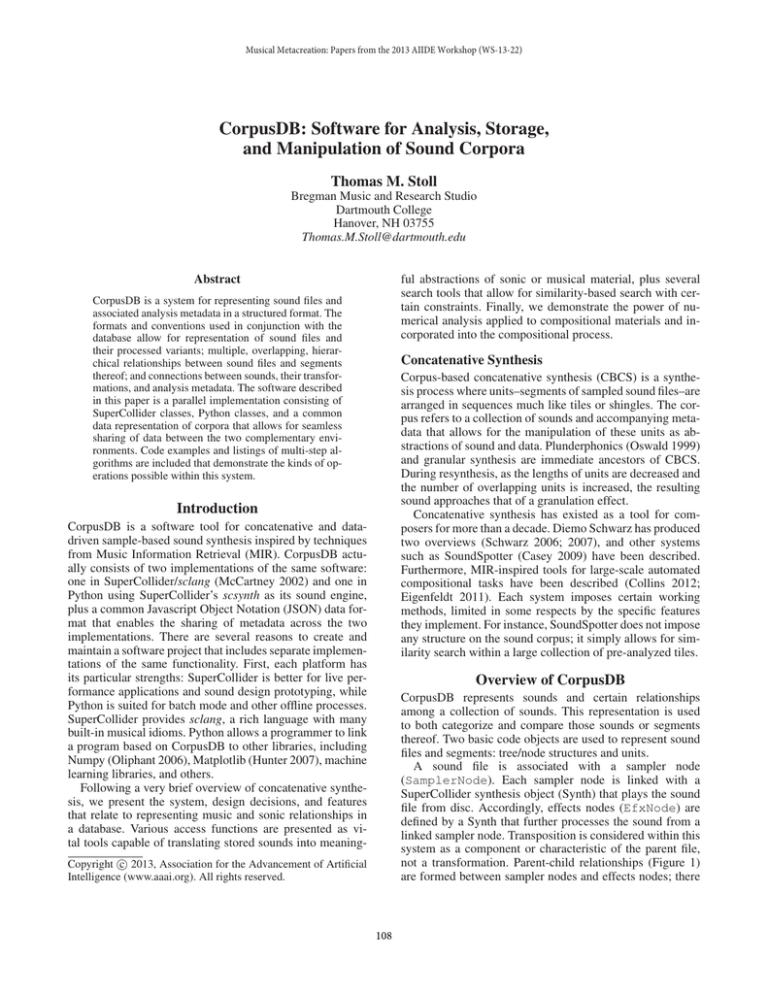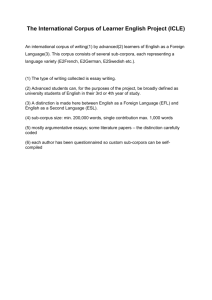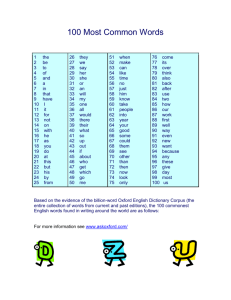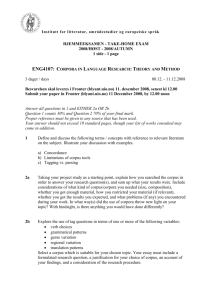
Musical Metacreation: Papers from the 2013 AIIDE Workshop (WS-13-22)
CorpusDB: Software for Analysis, Storage,
and Manipulation of Sound Corpora
Thomas M. Stoll
Bregman Music and Research Studio
Dartmouth College
Hanover, NH 03755
Thomas.M.Stoll@dartmouth.edu
Abstract
ful abstractions of sonic or musical material, plus several
search tools that allow for similarity-based search with certain constraints. Finally, we demonstrate the power of numerical analysis applied to compositional materials and incorporated into the compositional process.
CorpusDB is a system for representing sound files and
associated analysis metadata in a structured format. The
formats and conventions used in conjunction with the
database allow for representation of sound files and
their processed variants; multiple, overlapping, hierarchical relationships between sound files and segments
thereof; and connections between sounds, their transformations, and analysis metadata. The software described
in this paper is a parallel implementation consisting of
SuperCollider classes, Python classes, and a common
data representation of corpora that allows for seamless
sharing of data between the two complementary environments. Code examples and listings of multi-step algorithms are included that demonstrate the kinds of operations possible within this system.
Concatenative Synthesis
Corpus-based concatenative synthesis (CBCS) is a synthesis process where units–segments of sampled sound files–are
arranged in sequences much like tiles or shingles. The corpus refers to a collection of sounds and accompanying metadata that allows for the manipulation of these units as abstractions of sound and data. Plunderphonics (Oswald 1999)
and granular synthesis are immediate ancestors of CBCS.
During resynthesis, as the lengths of units are decreased and
the number of overlapping units is increased, the resulting
sound approaches that of a granulation effect.
Concatenative synthesis has existed as a tool for composers for more than a decade. Diemo Schwarz has produced
two overviews (Schwarz 2006; 2007), and other systems
such as SoundSpotter (Casey 2009) have been described.
Furthermore, MIR-inspired tools for large-scale automated
compositional tasks have been described (Collins 2012;
Eigenfeldt 2011). Each system imposes certain working
methods, limited in some respects by the specific features
they implement. For instance, SoundSpotter does not impose
any structure on the sound corpus; it simply allows for similarity search within a large collection of pre-analyzed tiles.
Introduction
CorpusDB is a software tool for concatenative and datadriven sample-based sound synthesis inspired by techniques
from Music Information Retrieval (MIR). CorpusDB actually consists of two implementations of the same software:
one in SuperCollider/sclang (McCartney 2002) and one in
Python using SuperCollider’s scsynth as its sound engine,
plus a common Javascript Object Notation (JSON) data format that enables the sharing of metadata across the two
implementations. There are several reasons to create and
maintain a software project that includes separate implementations of the same functionality. First, each platform has
its particular strengths: SuperCollider is better for live performance applications and sound design prototyping, while
Python is suited for batch mode and other offline processes.
SuperCollider provides sclang, a rich language with many
built-in musical idioms. Python allows a programmer to link
a program based on CorpusDB to other libraries, including
Numpy (Oliphant 2006), Matplotlib (Hunter 2007), machine
learning libraries, and others.
Following a very brief overview of concatenative synthesis, we present the system, design decisions, and features
that relate to representing music and sonic relationships in
a database. Various access functions are presented as vital tools capable of translating stored sounds into meaning-
Overview of CorpusDB
CorpusDB represents sounds and certain relationships
among a collection of sounds. This representation is used
to both categorize and compare those sounds or segments
thereof. Two basic code objects are used to represent sound
files and segments: tree/node structures and units.
A sound file is associated with a sampler node
(SamplerNode). Each sampler node is linked with a
SuperCollider synthesis object (Synth) that plays the sound
file from disc. Accordingly, effects nodes (EfxNode) are
defined by a Synth that further processes the sound from a
linked sampler node. Transposition is considered within this
system as a component or characteristic of the parent file,
not a transformation. Parent-child relationships (Figure 1)
are formed between sampler nodes and effects nodes; there
c 2013, Association for the Advancement of Artificial
Copyright Intelligence (www.aaai.org). All rights reserved.
108
Figure 2: Corpus unit row.
of metadata: all columns, just the index (or identifying)
metadata, just the amplitude metadata, or just the MFCC
metadata. Using the index metadata, access can be controlled so that only units meeting certain requirements are returned. For instance, one might construct a query that returns
only untransposed units (units with a transposition value of
1.0) that do not come from the same sound file. This can
be accomplished in a variety of ways: through the use of
list comprehensions, sclang list functions, Numpy’s search
functions, etc. Access filters of arbitrary complexity can be
chained together, and the results can be stored for future use.
Furthermore, introspective methods may be used to control
the quality of the data returned. For example, sets of units
returned may be subject to a minimum size requirement,
should the user require a certain minimum number of intermediate results to pass on to further stages of processing.
One important access-pattern bears special mention. It is
possible to tag units with integers that identify them in some
way. It is left to the user to define categories or some other labeling scheme. One possible example involves tagging units
as head, body, and tail units. A head unit is the first unit from
a sound file or those units identified as containing attacks of
sounds. A tail unit is the last unit of a sound file or those
units which precede units tagged as attacks in sound files
with multiple sonic events. By virtue of not being a head
or tail, all other units are labeled as body units, as Figure
3 shows. This tagging scheme allows for the grouping of
sounds so that a search amongst a group of tail units returns
a tail unit. This mitigates a situation where a unit tagged as
an attack potentially returns matches that do not contain attacks, and likewise, matches for body or tail units do.
Since units can be tracked as lists of integer indices, it
is easy to create multiple, overlapping groupings of units,
either on demand or offline. These groupings of units are
simple abstractions of sound material. This also means that
audio segments are always referred to symbolically, reducing computational complexity and memory requirements.
Figure 1: Parent and child nodes.
can be parent nodes with no children, but there are no freefloating child nodes. Each node contains a recipe for recreating the associated sound.
Given trees of sound-producing nodes, analysis metadata
is represented in the form of units. Each unit defines a link
between a segment of a sound file node and its metadata.
The majority of the data is collected automatically or as the
byproduct of dividing a sound into units. There is a tag category that allows the user to mark up each unit in a corpus
with an integer that can identify some user-specified aspect
of the underlying data. An example of the use of this tag
information is included below.
The relationships between parent and child nodes are encoded directly in the unit table for a corpus: a unit with
matching parent ID and sound file ID is a parent node,
whereas a unit with differing values is easily identified as
a child or effects node. These child nodes carry references
to their parents, so that their sound processing chains can be
reconstructed by connecting nodes. The depth of the tree is
currently limited, so that there can be no children of children.
Corpus units contain only integers and floating point numbers, and are meant to be useful for large-scale numerical processing. Each unit in a corpus contains information
identifying its source sound file, transposition, duration, as
well as the analysis metadata. Multidimensional raw analysis data (Mel-frequency Cepstral Coefficients or MFCCs)
collected per-frame are averaged over a segment comprised
of multiple frames. Parametric data–that is, data with a single value per frame–is stored as several statistical measures
over the whole segment: mean, max, initial and final values,
and the slope from initial to final value. In the current version, amplitude–actually, spectral power–parametric data is
collected. Overall, just two tables are maintained: the sound
file tree and the corpus-wide list of units.
Access to Corpus Data
The entire collection of segmented and analyzed sound file
units is available in a variety of forms. Depending on the
needs of the user, a corpus can be indexed globally, relative
to sound files, or relative to user-specified groupings or criteria. Global access to metadata is possible as both a mapping
between integer indices and metadata rows, or in a tabular
format.
These table views (Figure 2) can be limited by types
Figure 3: Tagging units.
109
Searching Corpus Data
Once sound files are analyzed and segmented, the resultant
metadata is accessed in order to perform a range of tasks.
The user can execute a series of modular operations in order to search, rank, reorder, swap, and otherwise manipulate sounds as segments or tiles. The targets for these search
steps are metadata from units, sequences or collections of
units, or even virtual representations of units (e.g., the mean
MFCC values over a combination of several actual units).
New unit sequences are created based on existing sequences,
via search protocols that may be designed with many different combinations of and variations on the following steps:
1
2
3
4
5
6
2. Select a target unit or sequence.
// all units not labeled as heads or tails
˜unitGrouping = mycorpus
.convertCorpusToTaggedArray(tag:0);
7
8
9
// calculate an array of weights
˜weights = [1, 0.98, 0.96, ...];
10
11
12
13
14
1. Group, filter, and partition units (see above).
// a particular target unit
˜targetUnit = mycorpus.cuTable[223];
15
16
// return the ten closest units
˜result = mycorpus.findNNearestWeighted(
targetUnit,
unitGrouping,
weights,
n:10);
3. Search by similarity (with optional weighting).
Figure 4: sclang code for finding similar units.
4. Re-rank, filter, or limit the number of results.
5. Reject results based on heuristics or analysis of results.
1
6. Represent the results in some form, either symbolically or
as resynthesized audio.
The selection of a unit or sequence of units to act as targets
for search, itself a significant choice, is left to the user. A
sequence of units can, and often does, correspond to a real
series of segments in a sound file or the results of a previous
substitution operation, although extensions to this method
are discussed below. It is possible to chain together a series
of searches for a unit similar to a target, using the resulting
unit as the target in each subsequent search. This is very
similar to classic concatenative synthesis, implemented in
a number of ways, notably in CataRT.
Selection and Search
Search-by-similarity, as currently implemented in
CorpusDB, is measured using Euclidean distance between MFCC data. Since the SuperCollider version is
focused on real-time use, KDTree (Stowell 2013), a plugin,
is useful for basic search-by-similarity. Various offline
comparison functions are included as part of a Python class.
These Python functions utilize Numpy for computations
involving large sets of numerical data. Since both versions
allow for the caching of search results, this allows for onetime calculations of nearest neighbors and the mapping of
each unit to a limited number of nearest units. The limiting
number functions as a cap on the potential connections
made between units within an analyzed corpus.
Search may be performed based on weightings or maskings of certain channels of search metadata. For instance,
search may be simplified by assigning higher weights to
the first few channels of MFCC data. Masking channels, by
completely stripping the same channels from both the target
unit and potential matches, serves to reduce the dimensionality of the data involved and can increase computational efficiency. Figure 4 demonstrates a series of simple operations
using sclang.
The ability to cache search results and store the resultant
rankings lends itself to weighted random selection. The distances of the nearest units may be used directly, or the rank-
2
3
4
5
6
# Create a pool of MFCC data for units
# with tag 0.
unitdata_pool = myCorpusDB
.convert_corpus_to_tagged_array(
’M’,
tag=0)
7
8
9
10
11
# Select random unit to serve as a target.
pool_size = unitdata.shape[0]
index = random.randint(0,pool_size)
target = unitdata_pool[index]
12
13
ct = CorpusTracker(myCorpusDB)
14
15
16
17
18
19
20
# Return the ten closest units to the
# target unit.
nearest_ten = ct.rank_units_by_euc_dist(
target,
unitdata_pool,
depth=10)
Figure 5: Python code for performing ranked search.
ings from closest to furthest may be mapped to a corresponding series of weights. Utilizing weighted random selection,
the nearest unit to the target is more likely to be chosen
than those further away. Furthermore, the rankings and/or
the weights might be stored and tracked as part of a dynamic
selection model where those rankings are adjusted after every search. Numpy and other libraries provide tools to work
with large sets of unit data. The code in Figure 5 demonstrates search using Python similar to the above sclang example.
Re-ranking, Filtering, and Limits on Search
Results
Once a series of nearby units has been gathered, a subsequent ranking made based on a distinct criterion may be used
to reorder the units. The re-ranking step refines the results
of the first search, which is based on matching similar ma-
110
terial. It is different from weighted random selection, in that
it re-ranks based on criteria independent, or partially independent, of the original distance measure. This re-ranking
step is an intuitive way to force a search algorithm to make
perceptually relevant decisions. For instance, if the original
selection is based on timbre similarity, a re-ranking based
on the average power values of the similar segments can be
designed to favor those with amplitudes similar to the target
unit’s and thus more amenable to insertion while minimizing
discontinuity (see the above discussion of tagged units).
A simple filtering of all units whose power is lower than
the target’s (or below an appropriate relatively lower threshold) will leave only those units that can be substituted with
a minimal amount of attenuation (or amplification) to match
the power of the target unit. This extension is inspired by
previous work (Maestre et al. 2006) specifically aimed at
segmentation of a corpus of prerecorded monophonic instrumental recordings, using the sounds’ amplitude envelopes to
guide concatenation. It must be stressed that the ordering of
the various phases of grouping, search, ranking, and general
post-processing is fairly open-ended and modular. The filtering of units according to power may happen as part of the
formation of pools of potential matches before search.
Multiple searches, with the results averaged or subjected
to a majority-voting scheme, are possible. More generally,
filtering and limiting of the number of results may be performed at any step. This last procedure, limiting the number
of results, is optional, but for practical purposes should be
performed when finally returning results or in intermediate
steps. It may be difficult to know how many results to retain;
it is left to the user to determine a workable limit.
1
2
3
4
5
all_transp_0_5 = ct.all_transpositions(0.5)
# ...
# all units with transp 0.5 are in our pool
mfccs_transp_0_5 = mfccs[all_transp_0_5]
amps_transp_0_5 = amps[all_transp_0_5][:,0]
6
7
8
9
10
# assume sound file 35 has transp = 0.5
sf_35_units = ct.all_of_sf(35)
sf_35_mfccs = mfccs[sf_35_units]
sf_35_amps = amps[sf_35_units]
11
12
13
result = []
for i,mfcc_row in enumerate(sf_35_mfccs):
14
15
16
17
18
ranked = ct.rank_units_by_euc_dist(
target_mfccs = np.atleast_2d(mfcc_row),
pool_mfccs = sf_35_mfccs,
depth = 1000)
19
20
21
22
reranked = ct.rerank_units_by_amp(
target_amp = amps_transp_0_5[i],
pool_amps = amps_transp_0_5[ranked])
23
24
25
26
filtered = ct.amps_greater_than(
subset_ids = reranked,
threshold_unit = int(sf_35_amps[i,0]))
27
28
result += filtered
Figure 6: Python code for complex multi-stage search.
ping of units in a sequence to similar units from a (sub)corpus can be used to create similar sequences of units
and thus comprises a particular way of producing remapped
sound files or variational edits. This is just one example of
how several of the above steps are combined. Most of the
above steps are facilitated by specific functions implemented
in both variants of CorpusDB. Of course users are free to
adapt their own functions or create new functions that fulfill
specific requirements.
Complex Search Example
In order to illustrate the use of several selection and search
functions, a more involved example is in order. While this
algorithm should return useful results, given sufficient numbers of units with compatible metadata, this example is primarily meant to show a multi-part search process. The following steps can be coded (see Figure 6) in either version of
the software:
Further extending the power of CorpusDB
1. Divide corpus into sub-corpora based on transposition
values (line 1).
The above sections outline the basic components of
CorpusDB and their use in building musical or compositional work flows. There are further extensions of the basic
functionality of CorpusDB that may be applied to the process of creating new series of sonic tiles.
2. Select a sound file to be the target (line 8) and iterate over
each of its units (line 13).
3. For each unit, search for the nearest unit, searching only
among the sub-corpus with the same transposition (line
15).
Searching on Sequences of Units
4. Limit the results of each search to the top 1000 hits after
ranking by calculated Euclidean distance (line 18).
When more than one target unit is used, the target unit becomes a sequence. The Python version of CorpusDB includes an implementation of a search function that searches
for one anchor unit as in Figure 7, and then re-ranks results
based on user-specified, variable numbers of neighboring
units. This is but one possible algorithm that would search
based on sequences. Furthermore, the algorithm allows the
user to specify a variable swap region: the units on which
search is based do not have to be the only units that are
swapped in for the target units.
5. Reorder those results based on the differences between
each result and the target unit’s amplitude (line 20). Filter
out any units with power, as averaged over the segment,
more than 3 dB below the target’s (line 24).
6. Collect the results of this re-ranking (line 28).
These results are stored for each unit in the sequence, and
a map from target units to corpus units is created. This map-
111
Figure 7: Search based on unit sequences.
The author has found that the results of a mapping from
targets to corpus oftentimes over-represents some units in
the corpus. These well-connected units are heard in resulting substitutions, and the ear can become attuned to the repetitions and familiarity caused by hearing them more often
in the results. This situation can be remedied by a postprocessing phase where the results lists are compared as a
group. Those units with a high rate of occurrence as potential matches are assessed a selection penalty (in a weighted
scheme) or removed altogether. This step will inhibit the selection of over-represented units, and, as a corollary, promote the relative representation of units with lower overall
connectivity within the corpus.
Figure 8: Similarity matrix.
segments are derived, construct sound files by sampling the
appropriate files based on timing data and metadata, identifying which file to use for each specific unit. It is straightforward to assemble the appropriate data and create audible
results of a swapping or remapping operation:
1. Gather a list of unit indices and convert that list into unit
metadata.
2. Iterate over that list and convert unit sequences that map
contiguous segments within the original sound files to
segments with onsets, durations, and sound file names.
Statistical Analysis and Views of Units
The observation that units are likely to be less than uniformly distributed within a corpus or subset thereof, leads
to a desire for analytical tools to inspect the results of a
search and view the relative distribution of units that comprise some grouping, or to view the general connectivity of
the corpus. Both implementations of CorpusDB, but especially the Python version, have functions that allow for the
introspection of corpora and other groupings of units.
It is easy to view units in terms of their relative connectivity, as based on timbral features. Using Numpy and Matplotlib, the Python version can be used to produce a distance
or similarity matrix (Figure 8) that shows the relative distances from each unit in the corpus to every other unit. This
example shows a corpus made up of two source sound files,
which can be seen in the graphic. Simple statistical analysis will reveal the means and variances across each channel
of multidimensional data. This statistical data can be used
in the search process to normalize distance functions so that
channels with large variance do not dominate channels with
relatively narrow ranges of values. While much of this analysis is possible using the sclang version, Python’s libraries
for numerical computation, graphing, and visualization are
superior and easier to use.
3. Loop over the assembled segments.
4. Pass each consecutive segment to a synthesis object(s)
that renders the sound. Compose the signal chain for parent sound file nodes and child or transformed nodes by
properly instantiating synthesis modules and connecting
audio buses.
5. Wait for the duration of each segment.
Using either version of CorpusDB, it is easy to implement
a function to perform the reconstruction offline and save the
result to disc. This method can allow for the rapid creation of
multiple variations on a target sound file. The SuperCollider
version includes functionality for online or real-time assembly of sound tile sequences. Both versions include example
code for assembling audio segments for playback.
Conclusion
This paper demonstrates several use-cases and applications
of the methods included as part of CorpusDB. The user is
left to construct organization and analysis algorithms composed of these methods that utilize the particular structure
of a CorpusDB instance in order to accomplish the desired musical goals. CorpusDB’s open-ended and modular design is intended to serve as the starting point for diverse algorithmic procedures including composition, analysis, exploration, etc. CorpusDB is open source software
available from github.com/kitefishlabs/CorpusDB (Python
Using Metadata to Drive Resynthesis and
Resampling
The results of search algorithms are lists of unit IDs that
correspond to segments of sound files. One must reconstruct
or, in the case where sequences of noncontiguous sound file
112
project) and github.com/kitefishlabs/cbpsc (SuperCollider
sclang project).
Acknowledgements
The author wishes to thank all the reviewers for their
thoughtful comments.
References
Casey, M. 2009. Soundspotting: a new kind of process. The
Oxford handbook of computer music 421.
Collins, N. 2012. Automatic composition of electroacoustic art music utilizing machine listening. Computer Music
Journal 36(3):8–23.
Eigenfeldt, A. 2011. Real-time composition as performance
ecosystem. Organised Sound 16(2):145–153.
Hunter, J. D. 2007. Matplotlib: A 2d graphics environment.
Computing in Science & Engineering 90–95.
Maestre, E.; Hazan, A.; Ramirez, R.; and Perez, A. 2006.
Using concatenative synthesis for expressive performance in
jazz saxophone. In Proceedings of International Computer
Music Conference, 219–222. San Francisco, California: International Computer Music Association.
McCartney, J. 2002. Rethinking the computer music language: Supercollider. Computer Music Journal 26(4):61–
68.
Oliphant, T. E. 2006. Guide to NumPy. Provo, UT.
Oswald, J.
1999.
Plunderphonics.
http://www.
plunderphonics.com/.
Schwarz, D. 2006. Concatenative sound synthesis: The early
years. Journal of New Music Research 35(1):3–22.
Schwarz, D. 2007. Corpus-based concatenative synthesis.
Signal Processing Magazine, IEEE 24(2):92–104.
Stowell, D. 2013. http://sourceforge.net/p/quarks/code/
2634/tree/DataStructures/KDTree/. Accessed: 2013-08-19.
113



